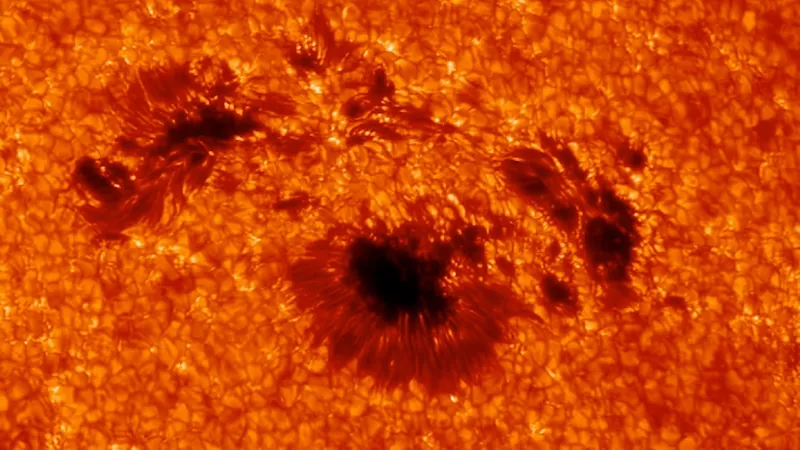
Scientists Uncover Massive 'Pimple' on Star, A Cosmic Mystery 7 Years in the Making!
2025-07-26
Author: Sarah
A Discovery Like No Other: The Cosmic 'Pimple' on TOI-3884
In a groundbreaking revelation, astronomers have detected a colossal feature—a starspot—on a distant star that has been plaguing it for at least seven years! This discovery came about during the observation of a giant planet, TOI-3884 b, which, while crossing its host star, displayed unusual transit signatures that led scientists to investigate further.
The Unique Planet: TOI-3884 b Revealed!
TOI-3884 b is no ordinary planet; it's a gas giant, 33 times the mass of Earth and similar to Neptune in nature. As it transits the tiny M-dwarf star TOI-3884, astronomers noticed a remarkable two-bump pattern in the star's light curve, unlike the typical single-step transit observed in most exoplanets.
Spotting the Starspot: What Makes This One Special?
First detected by NASA's Transiting Exoplanet Survey Satellite (TESS), the unusual transits triggered curiosity among scientists. In a previous study, they deduced that the star's surface brightness wasn’t uniform, leading to the hypothesis that the dimmer region was indeed a starspot—akin to the sunspots we observe on our Sun but far grander.
An Enormous Starspot, Dwarfing Solar Sunspots!
Utilizing TESS observations coupled with advanced computational models, astrophysicists from Harvard and MIT calculated that this starspot boasts a staggering radius of 76,000 miles (122,000 kilometers), covering about 7% of TOI-3884's surface. To put that into perspective, the largest sunspots observed on our Sun cover merely 0.3% of its surface area!
Longevity of the Starspot: A Cosmic Oddity
What’s even more extraordinary is the longevity of this starspot. Unlike sunspots, which typically last only a few months, TOI-3884's starspot, affectionately dubbed a 'pimple,' has persisted for a remarkable seven years, hinting at a cosmic phenomenon where starspots on rapidly rotating stars can last for decades.
Understanding the Intriguing Transit Patterns
To make sense of the starspot's influence on TOI-3884 b's transit pattern, scientists proposed two theories. The first suggests that the star's rotation period coincides with the planet's orbit, while the second posits that TOI-3884 b orbits above a massive, tilted starspot situated near one of the star’s poles.
Ruling Out Hypotheses: The Reality Exposed!
After rigorous calculations from their observations, researchers determined that the rotational period of TOI-3884 is 11 days, while TOI-3884 b transits every 4.5 days. This disproved the first hypothesis. Their modeling pointed to the conclusion that TOI-3884 b orbits in a near-perpendicular path relative to the star’s surface, further enriching the cosmic intrigue.
A Cosmic Puzzle: What’s Next?
The implications of this research continue to spark interest in the astronomical community. As researchers investigate further, they ponder what could have caused TOI-3884 b's unusual orbit—was it gravitational influences from another planet or a tilted disk of material at its birth? One thing is for certain: this discovery offers a tantalizing glimpse into the complexities of stellar compositions and planetary interactions!



 Brasil (PT)
Brasil (PT)
 Canada (EN)
Canada (EN)
 Chile (ES)
Chile (ES)
 Česko (CS)
Česko (CS)
 대한민국 (KO)
대한민국 (KO)
 España (ES)
España (ES)
 France (FR)
France (FR)
 Hong Kong (EN)
Hong Kong (EN)
 Italia (IT)
Italia (IT)
 日本 (JA)
日本 (JA)
 Magyarország (HU)
Magyarország (HU)
 Norge (NO)
Norge (NO)
 Polska (PL)
Polska (PL)
 Schweiz (DE)
Schweiz (DE)
 Singapore (EN)
Singapore (EN)
 Sverige (SV)
Sverige (SV)
 Suomi (FI)
Suomi (FI)
 Türkiye (TR)
Türkiye (TR)
 الإمارات العربية المتحدة (AR)
الإمارات العربية المتحدة (AR)